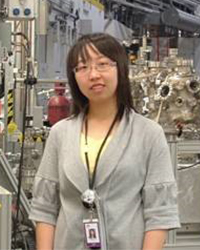Coming home as a faculty member
 In a much-anticipated homecoming, Lijia Liu has returned to Western, her alma mater, as a faculty member in the Department of Chemistry. Having first completed her PhD under supervisor TK Sham, Liu is now the latest addition to a growing group of researchers at the Centre for Advanced Materials and Biomaterials Research (CAMBR). Her expertise in synchrotron radiation spectroscopy is bringing a new dimension to the collaborative research at CAMBR, with uses ranging from bone implants to cancer therapy. “Synchrotron spectroscopy is a way of learning about advanced materials at the atomic level. We can use it to answer detailed questions about how and why materials behave the way they do, which is essential in medical applications,” explains Liu.
In a much-anticipated homecoming, Lijia Liu has returned to Western, her alma mater, as a faculty member in the Department of Chemistry. Having first completed her PhD under supervisor TK Sham, Liu is now the latest addition to a growing group of researchers at the Centre for Advanced Materials and Biomaterials Research (CAMBR). Her expertise in synchrotron radiation spectroscopy is bringing a new dimension to the collaborative research at CAMBR, with uses ranging from bone implants to cancer therapy. “Synchrotron spectroscopy is a way of learning about advanced materials at the atomic level. We can use it to answer detailed questions about how and why materials behave the way they do, which is essential in medical applications,” explains Liu.
One such application is in bone implants, like reconstructive plates or artificial joints. Often made of titanium or titanium alloys, the implants currently used by surgeons around the world do not mesh well with a patient’s surrounding bone tissue, which is often painful. “Cells cannot attach to the surface of a metal device, meaning there is no connection with the pre-existing bone,” says Liu; “this can cause the body to reject the implant, resulting in inflammation.” Liu and her collaborators are working to build a coating for implants made of calcium phosphate – the main ingredient in bones and teeth. “The coating is biocompatible, so it encourages the patient’s bone cells to attach to it, allowing the implant to be better accepted in the body,” she explains. “There are many different kinds of calcium phosphate compounds to be tested, which is where synchrotron spectroscopy comes into play – we can use it to understand which compounds create the best environment for bone cells to grow.” This technique is also vital to assess which compounds lead to bone implants being durable for many years.
Liu is also involved in a project to characterize gold nano-clusters for use in cell imaging and disease diagnostics, such as for tumours. “A few atoms of gold have different properties to a bulk amount of the same element which means they behave differently and can have different functions,” clarifies Liu. At such a small size, minute modifications affect the colour and light intensity of the nanoclusters, as well as how they bind to proteins. It is the light-emitting properties of these tiny molecules that scientists can use to track tumour cells. Synchrotron spectroscopy allows researchers to understand these materials at a fine level of detail they otherwise wouldn’t get from traditional chemical analysis.
Her beginnings at Western and subsequent postdoctoral fellowship at the University of Saskatchewan provided Liu with the theoretical toolkit that is now advancing a variety of exciting projects at CAMBR. As she continues her career at Western, she is making a point of getting involved in some of the existing projects at CAMBR while also devising new ones. With her family having arrived in London recently, Liu is looking forward to settling into her new-old home. “It’s like I never left!” she laughs.

